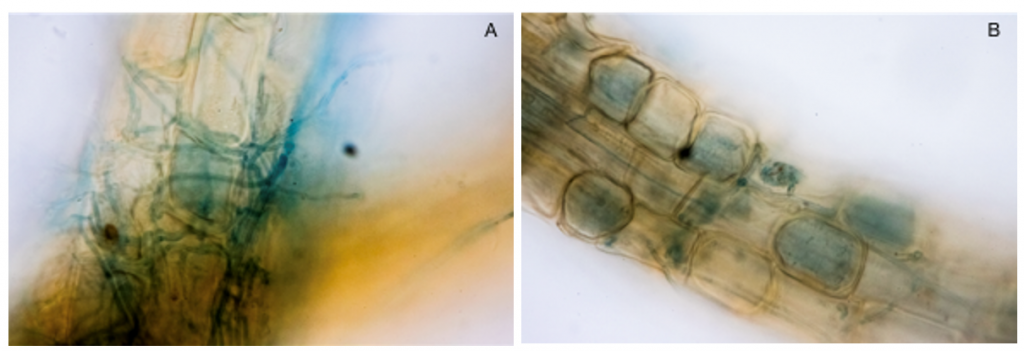Ericoid Mycorrhizal Fungi & Cranberry: Mutualisms with Potential
Becca Honeyball & Amaya Atucha
Mycorrhizal fungi are everywhere. These symbiotic organisms, a group of highly specialized root fungi, are naturally present in most every soil. In broad terms, mycorrhizae are the associations formed when mycorrhizal fungi colonize the roots of host plants, facilitating host plants’ uptake of water and nutrients (especially phosphorus, zinc, and copper) that otherwise may have not been accessible [8]. Mycorrhizae do this by acting as extensions of the plant’s existing root system, expanding upon the existing root zone by penetrating plant cells and tissues and increasing their connections to the soil. This increases the root system surface area that’s available for absorption, often resulting in improvements to plant growth and vigor, particularly in an environment of moisture stress and low nutrient availability. In return for these benefits, the host plant provides its mycorrhizal fungi with fuel in the form of sugars.
There are several distinct categories of mycorrhizal fungi, with different infection styles across mycorrhizal groups (detailed in Figure 1), and all of them share this feature of forming mutually beneficial associations (mutualisms) with host roots. Soil scientists estimate that about 80-90% of all terrestrial plant species experience some form of mycorrhizal symbiosis, and that mycorrhizal fungi comprise approximately 30% of all soil-borne organisms [8].

There has been research on mycorrhizal fungi and their beneficial plant interactions, which has resulted in the commercialization of many products containing mycorrhizal inoculants that promote increased plant health and productivity. However, these products are typically ineffective for cranberries. This is because species of mycorrhizal fungi that bond with cranberry roots, referred to as Ericoid mycorrhizal fungi (ErMF), are a unique and highly specialized group of mycorrhizal fungi that are not included in these products. ErMF that inoculate cranberry vines are “arguably the least researched and perhaps also the least understood type of mycorrhizal symbiosis[9].” Because of this, their development for use as an agricultural tool will take time.
ErMF are endophytes, meaning that the mycorrhizal association formed between plant and fungus remains inside the skin cells of cranberry’s thinnest roots, rather than producing any external structures.
The mycorrhizae connect to one another through long, branching filaments called fungal hyphae (shown in Fig. 2a). ErMF hyphae form the mycorrhizae by inserting themselves into the fine root cells, developing a tightly packed hyphal “coil” inside the cell, resulting in root volumes that are up to 80 percent fungal [7]. Examples of these hyphal coils can be seen stained blue in Figure 2b. The hyphae form a loose network around the root system and have an extremely high surface area, which is what facilitates uptake of otherwise unavailable nutrients [3].

Ericoid mycorrhizae, just as other types of mycorrhizae, increase the uptake of P, Zn, and Cu from the soil by the host plant—but in the case of ErMF it can also increase the uptake of N from the soil (Figure 3). A study in cranberry testing the Rhizoscyphus ericae species of ErMF (since renamed Hyaloscypha hepaticicola) demonstrated an increase in uptake of nitrate (NO3-) by cranberry vines when inoculated [1, 3, 9].

This assist in nitrate uptake may allow for lower nitrogen usage by growers while maintaining the same yield results. Indeed, multiple promising studies in other fruiting ericaceous plants support the notion of ErMF inoculation expanding tolerance of drought and nutrient stress [3, 5, 6], which bodes well for analogous studies in cranberry.
Mycorrhizal associations have historically been a rather mysterious factor in plant health, even more so with the less common groups like ErMF. As we learn more about ErMF and the role they play in nutrient cycling and stress mitigation, it’s plausible that we can adjust management practices to encourage these mutualisms and thereby afford crops another level of protection against environmental stress.
References
[1] Kosola et al, 2007. New Phytologist. 176: 184-196
[2] USDA National Agricultural Statistics Service, 2019. “Wisconsin Ag News – Cranberries”
[3] Baba et al, 2016. Microbes Environ. 31(2): 186-189
[4] Wisconsin State Cranberry Growers Association, 2013: “About Cranberries”
[5] Cairneey and Meharg, 2003. European Journal of Soil Science. 54(4): 735-740
[6] Jeliazkova and Percival, 2003. Canadian Journal of Plant Science. 83(3): 583-586
[7] Moore, D. (2011, June 01). “Ericoid mycorrhizas.” Retrieved from http://www.davidmoore.org.uk/assets/mostlymycology/dianehowarth/ericoid.htm
[8] O’Neil, 2018. Field Crops, Forages and Soils Updates for NNY. “What are Mycorrhizae and Should They Factor into Your Crop Management Plans?”’
[9] Vohník, 2020. Mycorrhiza. “Ericoid mycorrhizal symbiosis: theoretical background and methods for its comprehensive investigation.”
[10] Egerton-Warburton et al, 2005. Mycorrhizal Fungi: Reference Module in Earth Systems and Environmental Sciences. Elsevier, 2013. ISBN 9780124095489, https://doi.org/10.1016/B978-0-12-409548-9.05226-X
[11] Stackpoole, et al, 2008. Nitrogen conservation strategies of cranberry plants and ericoid mycorrhizal fungi in an agroecosystem. Soil Biology & Biochemistry, 40, 2736-2742. doi:10.1016/j.soilbio.2008.07.017
[12] Davenport et al, 1995. Cranberry Tissue Testing for producing beds in North America. Oregon State University Extension Service: EM 8610.
This article was posted in Cranberry and tagged Amaya Atucha, Becca Honeyball, Cranberries, Micohorrizae, Root health.
